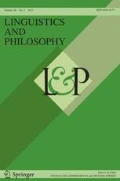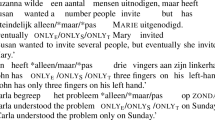Abstract
We claim that the meaning of the adverbial almost contains both a scalar proximity measure and a modal that allows it to work sometimes when proximity fails, what we call the at-a-distance reading. Essentially, almost can hold if the proposition follows from the normal uninterrupted outcomes of adding a small enough number of premises to a selection of relevant facts. Almost at-a-distance is blocked when the temporal properties of the topic time and Davidsonian event prevent normal outcomes from coming true when they need to. This approach to almost differs from the two general approaches that have emerged in the literature, by replacing the negative polar condition (not p) with a positive antecedent condition that entails not p while avoiding the numerous well-documented complications of employing a polar condition. Since this approach to almost involves a circumstantial base with a non-interrupting ordering source, almost behaves in certain ways like the progressive, and shows contextual variability of the same kinds that we see with premise sets.
Similar content being viewed by others
References
Abusch, D. (2012). Circumstantial and temporal dependence in counterfactuals. Natural Language Semantics, 20(3), 273–297. https://doi.org/10.1007/s11050-012-9082-5.
Amaral, P., & Del Prete, F. (2010). Approximating the limit: The interaction between quasi ‘almost’ and some temporal connectives in Italian. Linguistics and Philosophy, 33(2), 51–115. https://doi.org/10.1007/s10988-010-9075-0.
Barwise, J., & Cooper, R. (1981/2002). Generalized quantifiers and natural language. In P. Portner & B. H. Partee (Eds.), Formal semantics: The essential readings (pp. 75–126). Oxford: Blackwell.
Dowty, D. (1979). Word meaning and Montague Grammar. Amsterdam: Kluwer. 1991 reprint.
Hitzeman, J. (1992). The selectional properties and entailments of ‘almost’. Proceedings from the 28th meeting of the Chicago Linguistic Society (pp. 225–238). Chicago, IL: CLS.
Horn, L. R. (1985). Metalinguistic negation and pragmatic ambiguity. Language, 61(1), 121–174. https://doi.org/10.2307/413423.
Horn, L. R. (1989). A natural history of negation. Chicago, IL: University of Chicago Press.
Horn, L. R. (2002). Assertoric inertia and NPI licensing. In E. D. M. Andronis, A. Pycha, & K. Yoshimura (Eds.), Proceedings from the 38th meeting of the Chicago Linguistic Society, Part 2 (pp. 55–82). Chicago, IL: CLS.
Horn, L. (2011). Almost Forever. In K. Beals, E. Yuasa, & T. Bagchi (Eds.), Pragmatics and autolexical grammar: In honor of Jerry Sadock (pp. 3–21). Amsterdam: John Benjamins.
Iatridou, S., Anagnostopoulou, E., & Izvorski, R. (2001). Observations about the form and meaning of the perfect. In A. Alexiadou, M. Rathert, & A. von Stechow (Eds.), Perfect explorations (pp. 153–204). Berlin: De Gruyter.
Katz, G., Portner, P., & Rubinstein, A. (2012). Ordering combination for modal comparison. In A. Chereches (Ed.), Proceedings of SALT 22 (pp. 488–507). Washington, DC: Linguistic Society of America. https://doi.org/10.3765/salt.v22i0.2647.
Kilbourn-Ceron, O. (2017). Embedded exhaustification: Evidence from almost. Journal of Semantics, 34(1), 43–60. https://doi.org/10.1093/jos/ffw002.
Klecha, P. (2013). Diagnosing modality in predictive expressions. Journal of Semantics, 31(3), 443–455. https://doi.org/10.1093/jos/fft011.
Kratzer, A. (1977). What ‘must’ and ‘can’ must and can mean. Linguistics and Philosophy, 1(3), 337–355. https://doi.org/10.1007/BF00353453.
Kratzer, A. (1998). More structural analogies between pronouns and tenses. In D. Strolovitch & A. Lawson (Eds.), Proceedings of the 8th conference on Semantics and Linguistic Theory (pp. 92–110). Ithaca, NY: CLC Publications.
Kratzer, A. (2012). Modals and conditionals. Oxford: Oxford University Press.
Lassiter, D. (2011). Measurement and modality: The scalar basis of modal semantics. Dissertation, New York University.
Martin, F. (2005). Les deux lectures de faillir + inf. et les verbs présupposant l’existence d’un événement. In H. Bat-Zeev Shyldkrot & N. Le Querler (eds.), Les périphrases verbales (pp. 455–473). Amsterdam: John Benjamins.
McCawley, J. (1972). Kac and Shibatani on the grammar of killing. In J. Kimball (Ed.), Syntax and Semantics 1 (pp. 139–149). New York: Academic Press.
Moeschler, J. (2018). A set of semantic and pragmatic criteria for descriptive vs. metalinguistic negation. Glossa: A Journal of General Linguistics, 3(1), 58. https://doi.org/10.5334/gjgl.439.
Morgan, J. L. (1969). On arguing about semantics. Papers in Linguistics, 1(1), 49–70.
Morzycki, M. (2001). Almost and its kin, across categories. In R. Hastings, B. Jackson, & Z. Zvolenszky (Eds.), Proceedings of SALT 11 (pp. 306–325). Ithaca, NY: Cornell University.
Nouwen, R. (2006). Remarks on the polar orientation of ‘almost’. In J. van de Weijer & B. Los (Eds.), Linguistics in the Netherlands. Amsterdam: John Benjamins.
Penka, D. (2006). Almost there: The meaning of almost. In C. Ebert & C. Endriss (Eds.), Proceedings from Sinn und Bedeutung 10 (Vol. 2, pp. 275–286). Berlin: ZAS.
Portner, P. (1998). The progressive in modal semantics. Language, 74, 760–787. https://doi.org/10.2307/417002.
Portner, P. (2009). Modality. Oxford: Oxford University Press.
Rapp, I., & von Stechow, A. (1999). Fast ‘almost’ and the visibility parameter for functional adverbs. Journal of Semantics, 16, 149–204. https://doi.org/10.1093/jos/16.2.149.
Sadock, J. M. (1981). ‘Almost’. In P. Cole (Ed.), Radical pragmatics (pp. 257–271). New York: Academic Press.
Sevi, A. (1998). A semantics for almost and barely. MA thesis, Tel Aviv University.
Spector, B. (2013). Bare numerals and scalar implicatures. Language and Linguistics Compass, 7(5), 273–294. https://doi.org/10.1111/lnc3.12018.
Spector, B. (2014). Global positive polarity items and obligatory exhaustivity. Semantics and Pragmatics, 7(11), 1–61. https://doi.org/10.3765/sp.7.11.
Acknowledgements
We thank various audiences at the University of Kansas, including the Research in Field and Formal Linguistics seminar, as well as the Rutgers SURGE reading group. Parts of this research have been presented at WCCFL 36 and at the Modality Across Categories workshop, and the discussion from audiences there was very productive. We also appreciate direct feedback and assistance from Matt Menzenski, Aynat Rubinstein, Eric Wenski, and Samuel and Carol Newkirk. Thanks also to our editor, Paul Portner, for precise helpful commentary, and to almost all our anonymous reviewers for their insight, at every step along the way.
Author information
Authors and Affiliations
Corresponding author
Additional information
Publisher's Note
Springer Nature remains neutral with regard to jurisdictional claims in published maps and institutional affiliations.
Rights and permissions
About this article
Cite this article
McKenzie, A., Newkirk, L. Almost at-a-distance. Linguist and Philos 43, 389–426 (2020). https://doi.org/10.1007/s10988-019-09275-6
Published:
Issue Date:
DOI: https://doi.org/10.1007/s10988-019-09275-6




